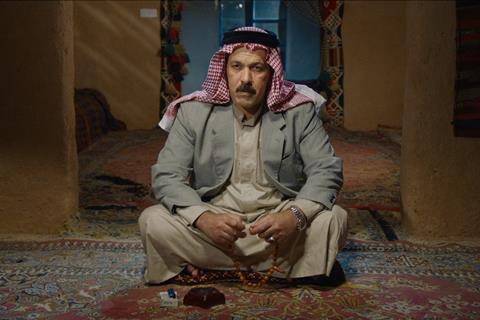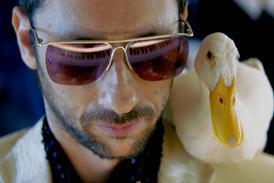Iraqi farmer Alaa Namiq explains how and why he hid Saddam Hussein from US forces in 2003

Dir: Halkawt Mustafa. Norway/Iraq. 2023. 96mins
The capture of Iraqi dictator Saddam Hussein by American forces in December 2003 after a nine-month manhunt is a story that played out in full view of the world. The fact he was found hiding in a small hole on a farm nine miles outside his hometown of Tikrit — a world away from the opulence of his presidential palaces — only added to global fascination. Two decades later, Norwegian-Kurdish filmmaker Halkawt Mustafa manages to shed new light on those events from the point of view of farmer Alaa Namiq, who sheltered Hussein for 235 days. Combining a straight-to-camera confessional of sorts with dramatisations and archive footage, Hiding Saddam Hussein is a compelling and sobering film.
A compelling and sobering film
Interest is likely to be strong following the film’s premiere in IDFA’s Frontlight section; the Iraq war and subsequent emergence of ISIS remains a hot topic, and this first-person historical account has substantial political and cultural value. It is also a well-constructed and enthralling documentary that gives a keen distributor much to work to in terms of both subject and craft.
In various press interviews he has conducted over the years, Namiq has come across as a man both honest and hesitant, proud and ashamed of his actions. The same is true here; sitting cross-legged, speaking directly to camera but often hiding his face in his hands, he is clearly attempting to reconcile how he feels about his experiences helping the man he still calls “master”, and the obvious condemnation of the wider world. (Namiq spent seven months in the notorious Abu Ghraib for his actions, before being released without charge.)
There is also a sense that, in making the film, Mustafa (whose 2016 feature El Clasico was selected as Iraq’s Oscar entry) is also trying to reconcile his own conflicting emotions. The director was forced to flee Iraq after Hussein’s persecution led to 180,000 of his fellow Kurds being deported, killed or disappeared. Having settled in The Netherlands, Mustafa began searching for Namiq in 2011; it took two years to find him and another three to get him him to tell his story, then filming was delayed for several years thanks to the rise of ISIS. Yet Mustafa remained doggedly determined to understand who Hussein was as a person and, while politics can never be entirely put to one side, he does succeed in showing a little-seen side to a monstrous figure.
Of course, this singular voice requires an audience to place their trust entirely in Namiq’s version of events, but he is engaging and open in sharing his memories. They range from the mundanity of cooking meals, cutting hair and passing time to visits from high ranking officials, with whom Hussein would plan military strategies, and sons Uday and Qusay just a few months before their deaths at the hands of American troops.
Namiq also explains how, as a 32 year-old father of four, he was surprised one night by a visit from Hussein and a small entourage, who gave him no choice but to help hide Hussein from American troops. “I am a bomb,” he recalls the president saying. “If I explode, I will take out you and your family.” There was fear, yes, but there was also a sense of duty; both to serve his beloved president — as a rural Iraqi with access only to state-run media, Namiq asserts he had no idea of Hussein’s dictatorial actions — and to fulfil the Arab custom of taking care of one’s guests. And so, during nine months of forced intimacy in which he spent little time with his own family, Namiq became Hussein’s driver, hairdresser, chef, confidante and something of a friend. He also admits that, given this new closeness, there was a hope he would become Hussein’s ‘right hand’ when he returned to power.
Namiq’s recollections are illustrated by sensitive re-enactments of key moments, and Mustafa resists the temptation to be overly dramatic with these segments. Namiq’s voice-over narrates the events as they unfold, and the action matches his measured tone; the same is true of the restrained score. Archive footage is well-chosen and shows both sides of the conflict; some remains difficult to watch and helps explain why, despite a $25m reward, Namiq felt it essential to protect his president at great potential personal cost.
Production companies: Hene Film
Contact: Hene Film halkawtm@gmail.com
Producers: Halkawt Mustafa , Janne Hjeltnes, Anders Herein
International sales: Hene Film
Cinematography: Kjell Vassdal, Anders Herein
Editing: Halkawt Mustafa
Music: Trond Bjerknes






![The Brightest SunScreen[Courtesy HKIFF]](https://d1nslcd7m2225b.cloudfront.net/Pictures/274x183/3/5/0/1448350_thebrightestsunscreencourtesyhkiff_312678.jpg)















![The Brightest SunScreen[Courtesy HKIFF]](https://d1nslcd7m2225b.cloudfront.net/Pictures/100x67/3/5/0/1448350_thebrightestsunscreencourtesyhkiff_312678.jpg)

